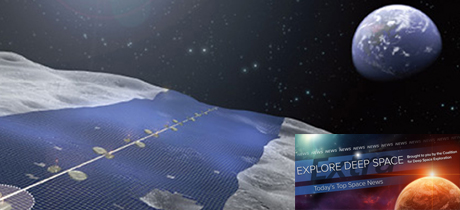In Today’s Deep Space Extra… NASA asks U.S. industry to study solar electric power technologies for the agency’s proposed Deep Space Gateway (DSG), an international lunar orbiting habitat.
Human Space Exploration
NASA selects studies for Deep Space Gateway (DSG) power and propulsion element
Coalition Member in the News (Boeing, Lockheed Martin, Orbital ATK)
NASA Goddard Space Flight Center (11/2): NASA’s proposed Deep Space Gateway (DSG), a lunar orbiting human habitat, would need a power and propulsion source, one capable of generating 50 KW. The agency has selected five companies to assess how it could step-up current levels of Solar Electric Propulsion technologies available to satellites to meet the DSG requirement. The five companies selected are Boeing, Lockheed Martin, Orbital ATK, Sierra Nevada and Space Systems/Loral. NASA will spend $2.4 million on the four month study.
Governor Edwards and NASA’s Todd May highlight growth at Michoud Assembly Facility
Coalition Member in the News (Boeing)
KALB-TV (11/1): Louisiana Governor John Bel Edwards joined with Todd May, Director of NASA’s Marshall Space Flight Center, to mark growth at NASA’s Michoud Assembly Facility, the New Orleans facility where the agency’s Orion capsule and Space Launch System (SLS) core stage are manufactured. Some 200 jobs have been added by Boeing this year, and more growth is anticipated as the U.S. prepares to resume human deep space exploration.
Space Science
Spending time in space may cause astronauts’ brains to float upward
The Verge (11/1): Studies reported in the New England Journal of Medicine on Wednesday suggest the human brain repositions when exposed to the microgravity of spaceflight. In all, observations of 34 astronauts assigned to space shuttle and International Space Station missions were compared. It’s unclear how the changes affect astronaut health.
Earth-sized alien worlds are out there. Now, astronomers are figuring out how to detect life on them
Science (11/1): University of California, Riverside, astronomer Stephen Kane and colleagues are hopeful their studies of Earth through imagery provided by NASA’s Deep Space Climate Observatory will help them identify bio signatures on distant planets orbiting faraway stars.
Candidate ‘passengers’ picked for potential 1st interstellar mission
Space.com (11/1): Nematodes and tardigrades, aka water bears, could be among the most suitable candidates for interstellar travel, according to a presentation before a NASA Innovative Advanced Concepts gathering in Denver. Philip Lubin, head of the Starlight program at the University of California, Santa Barbara, made the case.
Other News
The space industry will be worth nearly $3 trillion in 30 years, Bank of America predicts
CNBC (10/31): A Bank of America/ Merrill Lynch forecast assumes strong growth of the current $350 space billion market based on new and disruptive technologies and falling launch costs.
Contentious Bridenstine nomination hearing splits along party lines
Spacepolicyonline.com (11/1): Today’s contentious nomination hearing for Rep. Jim Bridenstine (R-OK) to be NASA Administrator was split along partisan lines. Democratic Senators questioned his credentials and viewpoints about climate change, sexual harassment and other issues that could affect how he runs the agency and its personnel. Republicans defended him and chafed at the tenor of the hearing. The committee could vote as early as next week on whether to send the nomination to the full Senate.

